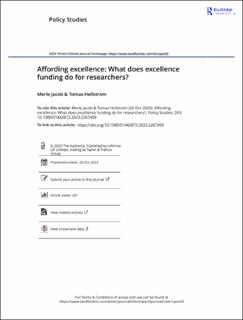Affording excellence: What does excellence funding do for researchers?
Journal article, Peer reviewed
Published version

Åpne
Permanent lenke
https://hdl.handle.net/11250/3123106Utgivelsesdato
2023Metadata
Vis full innførselSamlinger
Sammendrag
The ambitions to fund excellent researchers and path-breaking research unite a whole family of funding instruments ranging from Centres of Excellence to individual grants. While instruments aimed at funding excellence share a number of commonalities, there are important subsidiary features which determine their overall efficacy. The paper uses a case study of the Swedish Distinguished Professor Grant (DPG) to investigate the role of subsidiary features in enabling conditions associated with path-breaking research. Interviews were conducted with DPG recipients, to develop an “affordance analysis” identifying how features of the instrument enabled certain researcher actions and opportunities. Results suggest that while long duration and large funds are central to research excellence, the way in which subsidiary features such as reporting, planning and content requirements are structured affect the level of risk-taking. In terms of policy, the paper offers specific and general suggestions for the design of excellence funding instruments.
